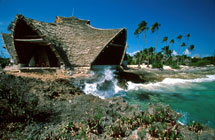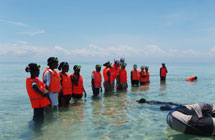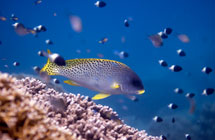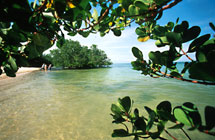Chumbe Island
Chumbe Island is situated just opposite Stonetown, Zanzibar’s capital and is a rare example of a still pristine coral island ecosystem in an otherwise heavily overfished and over-exploited area.





Chumbe Island
Chumbe Island is situated just opposite Stonetown, Zanzibar’s capital and is a rare example of a still pristine coral island ecosystem in an otherwise heavily overfished and over-exploited area. Chumbe Island Coral Park is a privately managed nature reserve developed and managed by the non profit Chumbe Island Coral Park Ltd. (CHICOP). The reserve includes a reef sanctuary -the first marine park in Tanzania- and a forest reserve. The marine park was officially recognized by the Zanzibar government in 1994 and has provided a protected breeding ground for fish, corals and other species which have ever since spread out to recolonise the nearby areas. This made Chumbe’s protection of vital importance to both the preservation of bio-diversity and the local communities. It also attracted other species like seabirds, lobsters and the rare robber or coconut crab (birgus latro).
Today, the tiny Chumbe Island is globally recognized as a leading example of true ecotourism: guests visit Chumbe to spend some special time close to nature, snorkeling, and walking around. Special care is taken so that all products are organic, even the soaps that are produced by a local women’s co-operative in Zanzibar. All the non-organic products like plastic bags and bottles are avoided and there is no illumination of nature trails and beach areas during the night in order not to disturb the nocturnal animals. Instead guests are equipped with solar powered torches.
While you might need to sacrifice some of the comforts you are used to enjoy, at the same time you will have the rare opportunity to explore the beauties of this secluded Island, either on your own or under the guidance of the park’s rangers. The rangers are mostly former fishermen from adjacent villages that were trained from the beginning, raising in this way awareness among the local community on marine ecology and sustainable management of natural resources. You can also snorkel through the shallow waters of the reef sanctuary, or we can arrange a scuba diving excursion to the nearby reefs. Swim up to the reef ridge to watch the view opening up a world of breathtaking sights: shoals of barracuda, dolphins, batfishes, hawksbill turtles that may allow you to accompany them, blue spotted stingrays, colorful parrotfish and many more fishes -nearly 400 species in total that don’t seem to be disturbed by the human presence as there has been no fishing for many years.
Another interesting option is walking around the island, especially when the tide is low and the bottom of the sea is revealed. What looks like a rainforest from a distance is actually a highly specialized plant community that survives without any groundwater capturing the moisture from the humid air and storing the rainfall during the rainy seasons. Almost 90% of Chumbe is covered by this virgin coral rag forest of spectacular density. Roots thrust out in all directions and epiphytic species cling to life by wrapping themselves around all available surfaces. Researchers have taken up to four hours to transverse the 1 km stretch through the central forest reserve but for guests there is a network of nature trails that allows for an insight into this otherwise virtually impenetrable habitat. While walking through these trails, you will discover that the bedrock of the island is made up of an impressive substrate of fossilized coral. The skeletal structures of corals and giant clams can still be seen, – a reminder of the passage of time. If you’re lucky enough you might see the rare Ader’s duiker which was translocated here from Zanzibar in order to prevent its extinction.
Don’t leave the island without climbing -at least once- the 131 steps to the top of the island’s Lighthouse, built in 1904 by the Sultan of Zanzibar and the British. Especially at sunrise the view of the turquoise seas between mainland Tanzania and Zanzibar from the top is simply breathtaking.
Chumbe Island can be visited all year round, as a destination in each own right or combined for 1-2 days trip with your Zanzibar vacations.
Islands & Coasts
